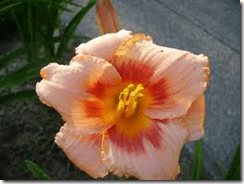While the individual flowers last only a day (hence the name), daylilies are among the hardiest of flowering plants. Also known by their scientific name, Hemerocallis, daylilies grow in nearly any kind of soil and can tolerate shade or sun. When they get crowded, you can increase their flowering by dividing them and transplanting elsewhere. In the spring, when the leaves of the daylilies are 3 or more inches high but well before you expect flowering, you may divide the plants, and they will have time to recover enough to bloom later in the summer.
- Difficulty:
- Moderately Easy
Instructions
Things You’ll Need
- Daylilies still in the ground
- Bucket or cardboard box
- Shovel or large garden fork
- Trowel
- Sharp utility knife
- Water
Dividing Large Clumps
- Dig up the plants to be divided. If you are working with dozens and dozens of common tawny (orange) daylilies that have overtaken a bed, you can use a shovel or garden fork to lift them out in clumps.
- For densely tangled plants, the National Arboretum website suggests you use two shovels or garden forks to separate a large clump into two or more smaller clumps. Put the shovels or forks in the middle of the clump and work them apart. Use your fingers to loosen the plants within the clump. Experts are divided (no pun intended) about whether you should completely divide the plants into separate individuals or leave them in clumps. In the spring, the plants may be easier to separate–or they may be so tender you would rather leave them in clumps.
- Replant the smaller clumps into the same bed or transplant elsewhere. To replant clumps, dig a hole somewhat larger than the clump and loosen the soil in the bottom of the hole. Carefully place the clump in the hole and sprinkle soil around the edges. Tamp down gently to remove air pockets, water well but don’t drown.
Dividing Individual Plants
- If you have unusual cultivars that cost $15 apiece or more, you will want to treat them more gently than the "clump" method. Use the trowel to gently loosen the soil around the plant and lift out. This is often easier to do if the soil is somewhat dry and crumbly. Or if you are dealing with clay or other hard soil, you might want to water it first to soften it for working.
- Separate the roots, which will have thick parts called rhizomes, as well as thin feeder roots. All parts of the roots from various individual plants will most likely be tangled together. In addition, the plants of many varieties remain connected to the "mother" plant. Cut them apart with a sharp knife. The Abundant Daylilies website advises rinsing off the soil and gently pulling one or more "fans" of leaves from the clump. Use the knife for difficult tangles. It’s better to have a clean cut than a jagged tear.
- Rinse the plants and let them them dry in the shade several hours or overnight to heal.
- Replant the daylilies you had planned to keep in the original bed, if any, and transplant those you are moving to another bed. Loosen the soil in the hole, make a small mound on which to spread out the roots, and cover with soil. Tamp down gently to eliminate air pockets. Water and cover with mulch to retard weeds. Plant a foot or more apart, depending on whether you are planting small individual plants or small clumps. The clumps need more room, but regardless of their size, they’ll soon fill up the space.
- Consider packaging and labeling individual cultivars in wax paper bags or paper bags for sharing or perhaps selling at a garden club sale. Don’t let them dry out unduly, but avoid too much moisture, which will encourage mold. Get the divided plants back into the ground within a few days if possible.
Tips & Warnings
-
Several garden sites agree that daylilies can be divided at just about any time during the growing season. Some advise that the best time to divide daylilies is after they have bloomed in the summer, especially in the southern parts of the United States. But in northern climates, spring could be a better time, as the plants will have more time to grow new roots before winter.


Deprecated: strpos(): Passing null to parameter #1 ($haystack) of type string is deprecated in /home/agriviek8Qv/agriviet.net/public_html/wp-includes/comment-template.php on line 2522